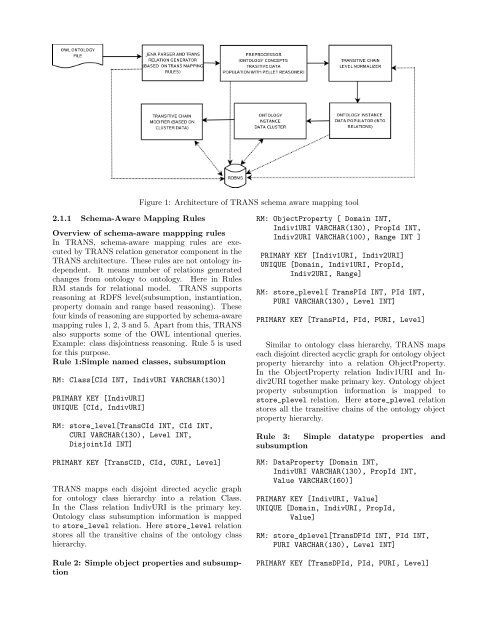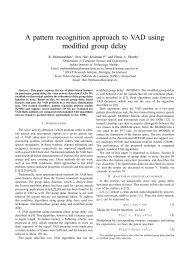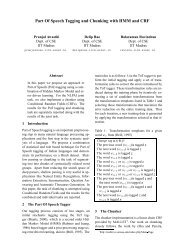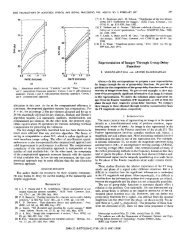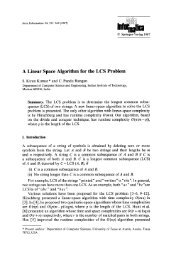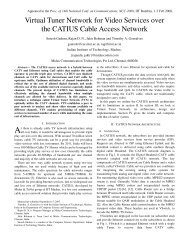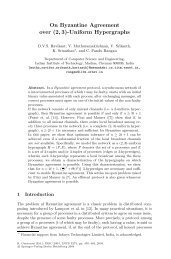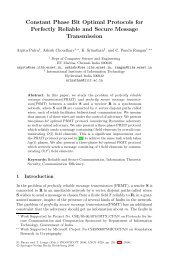TRANS: Schema-Aware Mapping of OWL Ontologies into Relational ...
TRANS: Schema-Aware Mapping of OWL Ontologies into Relational ...
TRANS: Schema-Aware Mapping of OWL Ontologies into Relational ...
Create successful ePaper yourself
Turn your PDF publications into a flip-book with our unique Google optimized e-Paper software.
Figure 1: Architecture <strong>of</strong> <strong>TRANS</strong> schema aware mapping tool<br />
2.1.1 <strong>Schema</strong>-<strong>Aware</strong> <strong>Mapping</strong> Rules<br />
Overview <strong>of</strong> schema-aware mappping rules<br />
In <strong>TRANS</strong>, schema-aware mapping rules are executed<br />
by <strong>TRANS</strong> relation generator component in the<br />
<strong>TRANS</strong> architecture. These rules are not ontology independent.<br />
It means number <strong>of</strong> relations generated<br />
changes from ontology to ontology. Here in Rules<br />
RM stands for relational model. <strong>TRANS</strong> supports<br />
reasoning at RDFS level(subsumption, instantiation,<br />
property domain and range based reasoning). These<br />
four kinds <strong>of</strong> reasoning are supported by schema-aware<br />
mapping rules 1, 2, 3 and 5. Apart from this, <strong>TRANS</strong><br />
also supports some <strong>of</strong> the <strong>OWL</strong> intentional queries.<br />
Example: class disjointness reasoning. Rule 5 is used<br />
for this purpose.<br />
Rule 1:Simple named classes, subsumption<br />
RM: Class[CId INT, IndivURI VARCHAR(130)]<br />
PRIMARY KEY [IndivURI]<br />
UNIQUE [CId, IndivURI]<br />
RM: store_level[TransCId INT, CId INT,<br />
CURI VARCHAR(130), Level INT,<br />
DisjointId INT]<br />
PRIMARY KEY [TransCID, CId, CURI, Level]<br />
<strong>TRANS</strong> mapps each disjoint directed acyclic graph<br />
for ontology class hierarchy <strong>into</strong> a relation Class.<br />
In the Class relation IndivURI is the primary key.<br />
Ontology class subsumption information is mapped<br />
to store_level relation. Here store_level relation<br />
stores all the transitive chains <strong>of</strong> the ontology class<br />
hierarchy.<br />
Rule 2: Simple object properties and subsumption<br />
RM: ObjectProperty [ Domain INT,<br />
Indiv1URI VARCHAR(130), PropId INT,<br />
Indiv2URI VARCHAR(100), Range INT ]<br />
PRIMARY KEY [Indiv1URI, Indiv2URI]<br />
UNIQUE [Domain, Indiv1URI, PropId,<br />
Indiv2URI, Range]<br />
RM: store_plevel[ TransPId INT, PId INT,<br />
PURI VARCHAR(130), Level INT]<br />
PRIMARY KEY [TransPId, PId, PURI, Level]<br />
Similar to ontology class hierarchy, <strong>TRANS</strong> maps<br />
each disjoint directed acyclic graph for ontology object<br />
property hierarchy <strong>into</strong> a relation ObjectProperty.<br />
In the ObjectProperty relation Indiv1URI and Indiv2URI<br />
together make primary key. Ontology object<br />
property subsumption information is mapped to<br />
store_plevel relation. Here store_plevel relation<br />
stores all the transitive chains <strong>of</strong> the ontology object<br />
property hierarchy.<br />
Rule 3: Simple datatype properties and<br />
subsumption<br />
RM: DataProperty [Domain INT,<br />
IndivURI VARCHAR(130), PropId INT,<br />
Value VARCHAR(160)]<br />
PRIMARY KEY [IndivURI, Value]<br />
UNIQUE [Domain, IndivURI, PropId,<br />
Value]<br />
RM: store_dplevel[TransDPId INT, PId INT,<br />
PURI VARCHAR(130), Level INT]<br />
PRIMARY KEY [TransDPId, PId, PURI, Level]


